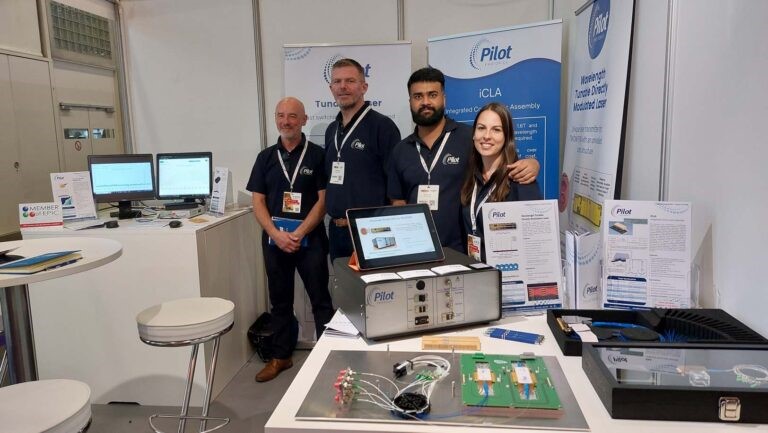Pilot Photonics' Hybrid Laser Breakthrough As the demand for AI acceleration, cloud computing, and...
COCOPOP: Coherent Comb for Co-Packaged Optics for AI/ML Datacentres
At Pilot Photonics, we are contributing to one of the key challenges in AI: How do we continue to scale datacentre capacity and processing power, while reducing the energy required.
Backed by €2.5M in funding from the European Innovation Council’s HORIZON-EIC-2023-TRANSITION CHALLENGES programme, our project COCOPOP (Coherent Combs for Co-packaged Optics) is developing the world’s first comb-based External Laser Source (ELS). This isn’t just about more bandwidth — it’s about future-proofing the digital world.
The Challenge: Scaling Optical Interconnects in AI and Cloud Data Centres
The rapid growth of AI/ML, cloud computing, and data-intensive applications is pushing datacentres to their limits. Meeting these demands requires new levels of optical interconnect scalability. Today’s optical links inside datacentres typically rely on 1, 4, or 8 wavelengths, often using the CWDM4 grid. However, CWDM4, with its wider channel spacing and susceptibility to dispersion, doesn’t scale efficiently.
To address the limitations of faceplate density, power consumption, and signal integrity, the industry is transitioning toward Co-Packaged Optics (CPO) and Optical I/O (OIO), architectures that place optics closer to the switch ASIC. This brings performance gains, but also introduces a new challenge: the laser sources at the heart of these systems must now meet stricter requirements for power, wavelength accuracy, and scalability.
Laser arrays, commonly used in these systems, provide high per-channel power but struggle with wavelength accuracy and stability over time, which becomes critical as the number of wavelengths per fibre is scaled. Furthermore, scaling through fibre count is already reaching limits. When wavelengths per fiber, and number of fibers start to saturate, the remaining scaling axis is data rate per wavelength.
Today’s systems rely on relatively simple Intensity Modulation / Direct Detection (IM/DD). Coherent communication, used today in longer optical links, enables data to be packed much more densely onto a channel. However, coherent is also more complex. It requires a stable, narrow-linewidth, laser at both the transmit side and the receive side and the wavelengths of each must be tightly aligned for successful communication. This is where simple laser arrays being proposed will struggle and this is the bottleneck that COCOPOP is working to eliminate. A 16 wavelength CPO system using laser arrays would need 32 lasers to be controlled and locked to each other in pairs.
In contrast with a 16 wavelength comb laser on both sides, there is only one "tuning knob" required to bring-up all channels. By delivering a coherent-capable ELS based on chip-scale comb technology, COCOPOP addresses the critical need for scalable, stable, and high-performance light sources for today’s systems and also unlocks the next generation of datacentre capacity using coherent communication inside the datacentre. In our view, the question isn’t if the datacentre goes coherent, it’s when. And COCOPOP makes that possible.
The COCOPOP Solution
COCOPOP is developing the world’s first comb-based ELS. We call it ExCELS - External Comb-enhanced Laser Source – and it overcomes one of the key challenges that has plagued comb lasers to date: low power per wavelength. Integrating a chip-scale optical frequency comb to synchronise, lock and stabilise an integrated laser array, the architecture achieves the phase coherence and wavelength precision of a comb, while retaining the high power per wavelength and power efficiency of a laser array. 
Figure 1 – (Left) ExCELS Architecture comprising an optical frequency comb that injection-locks a laser array
The result? More wavelengths, more power, tighter spacing (aligned with the CW-WDM MSA grid), higher wavelength accuracy and stability, lower noise and improved data throughput — all in a chip-scale and pluggable solution. Suitable for today's high data-rate IM/DD but also unlocking the third scaling dimension by enabling coherent modulation and detection.
Some of the key developments in the COCOPOP so far include:
CW-WDM 16-Channel Laser Array
 Pilot Photonics has developed a 16-channel photonic integrated circuit, aligned to the CW-WDM MSA O-band grid with 200 GHz spacing. Originally designed as the injection-locked demultiplexer for the COCOPOP comb-based ELS, ExCELS, this PIC can also function as a standalone ELS for today’s IM/DD systems.
Pilot Photonics has developed a 16-channel photonic integrated circuit, aligned to the CW-WDM MSA O-band grid with 200 GHz spacing. Originally designed as the injection-locked demultiplexer for the COCOPOP comb-based ELS, ExCELS, this PIC can also function as a standalone ELS for today’s IM/DD systems.
Now part of Pilot Photonics' commercial product portfolio, this PIC reinforces Pilot Photonics’ strategic role in shaping the CW-WDM ecosystem, further supported by the company’s recent membership in the CW-WDM MSA.
Figure 2 – Laser array PIC and overlapped spectra of the 16 channels.
Scalable SiN Comb Sources in C- and O-band
COCOPOP has demonstrated optical frequency comb generation with two integrated photonic structures: a Silicon Nitride (SiN) micro-ring resonator and a SiN Bragg resonator comb.
ExCELS ELSFP - A Comb-based ELS
 Designed for pluggable form factors, ExCELS enables coherent-capable transmission inside data centres, aligning with the CW-WDM MSA and future-proofing AI and cloud-scale networks.
Designed for pluggable form factors, ExCELS enables coherent-capable transmission inside data centres, aligning with the CW-WDM MSA and future-proofing AI and cloud-scale networks.
A final architecture for the pluggable ExCELS was selected and two photonic integrated circuit (PIC) fabrication runs were completed: one in Silicon Nitride (SiN) for comb generation and one in Indium Phosphide (InP) for the demux laser array.
An ELSFP-compliant housing has been sourced, and integration is underway.
Figure 3 – ELSFP pluggable, and flyers for ExCELS
COCOPOP is just getting started, and the most exciting breakthroughs are yet to come. Stay tuned as we bring ExCELS to market and reshape the future of datacenter optics.

Further information is available here:
Optical Parallelism - Comb Lasers or Laser Arrays for Next-Generation Interconnects
Gazettabyte - Home - A coherent roadmap for co-packaged optics




